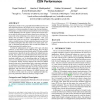Free Online Productivity Tools
i2Speak
i2Symbol
i2OCR
iTex2Img
iWeb2Print
iWeb2Shot
i2Type
iPdf2Split
iPdf2Merge
i2Bopomofo
i2Arabic
i2Style
i2Image
i2PDF
iLatex2Rtf
Sci2ools
IMC
2009
ACM
2009
ACM
Moving beyond end-to-end path information to optimize CDN performance
Replicating content across a geographically distributed set of servers and redirecting clients to the closest server in terms of latency has emerged as a common paradigm for improving client performance. In this paper, we analyze latencies measured from servers in Google’s content distribution network (CDN) to clients all across the Internet to study the effectiveness of latency-based server selection. Our main result is that redirecting every client to the server with least latency does not suffice to optimize client latencies. First, even though most clients are served by a geographically nearby CDN node, a sizeable fraction of clients experience latencies several tens of milliseconds higher than other clients in the same region. Second, we find that queueing delays often override the benefits of a client interacting with a nearby server. To help the administrators of Google’s CDN cope with these problems, we have built a system called WhyHigh. First, WhyHigh measures client ...
Client Latencies | Clients Experience Latencies | IMC 2009 | Internet Technology | Inflated Latencies |
| Added | 28 May 2010 |
| Updated | 28 May 2010 |
| Type | Conference |
| Year | 2009 |
| Where | IMC |
| Authors | Rupa Krishnan, Harsha V. Madhyastha, Sridhar Srinivasan, Sushant Jain, Arvind Krishnamurthy, Thomas E. Anderson, Jie Gao |
Comments (0)

